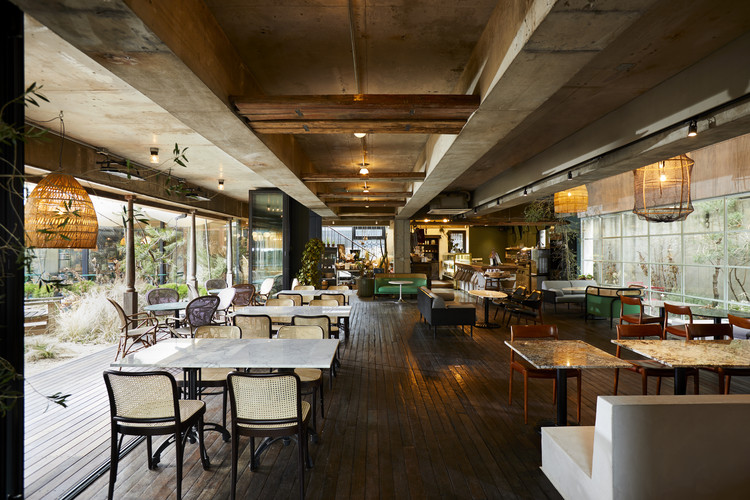House of January Studio
2013-01-16 00:00
架构师提供的文本描述。这座房子坐落在韩国最平静、最美丽的城市-济州岛郊区的一个名为班沃尔的村庄里。北面有松林,南边有果园,最奇特的地方是在西边,有一个家族的墓地。这个墓地也确定了村庄的外部边界。村名班沃尔(意为半月)也是深奥的,象征着月亮衰弱和打蜡的界限变得模糊的时刻。遥远的村庄在东部,是体育场,国际足联世界杯比赛在11年前举行。转向遥远的东南,“莫克山”(意为一座巨大的山)肉眼可见。
Text description provided by the architects. The house sits in a village called Banwall on the outskirts of Jeonju, one of the most calm and beautiful city of Korea. With a pine forest on north and an orchard on south, what is most peculiar about the site is on the west, shouldering to a graveyard for some family clan. This graveyard also defines the outer boundary of the village. The village name Banwall (meaning Half-moon) is also profound, signifying the moment of when the distinction between moon waning and waxing becomes blur. Remote over the village on the east, is the stadium where FIFA Worldcup game was held 11 years ago. Turning to the far south-east, ‘Moak mountain’ (meaning a huge mountain) is visible to the naked eye.
这所房子必须建在几个分界路口;在死者和活人之间;在不同的地面之间;在老工作和客户的新开始之间.设计房子就像制造一扇跨越边界的大门。我们希望这所房子能像一本被遗忘的故事书中的人物一样,拥抱一种平静而不受限制的生活。
The house had to be erected on several crossings of demarcation; between the dead and living; between various levels of ground; between old job and new beginning for the client... Designing the house was like making a gate that transcends the boundaries. We hoped the house would embrace a peaceful and unrestricted life like a character in a forgotten story book.
根据从南到东的缓慢坡度,这座房子是自然的。一分为二,一种是木制的,一种是家庭生活,另一种是用红砖完成的,它包含了用户夫妇的娱乐和休息。一个朝南,另一个朝东,正对着远山。这两个人在中间离开,为一个没有明确形状的马当留下了空间。
The house posits naturally according to the slow slope from south to east. Split in two, one with wooden exterior incorporates domestic life, whereas the other finished in red brick encompasses recreation and repose of the user couple. One faces due south, the other turns itself a little to the east, properly facing the far mountain. The two departs in the middle to leave space for a Madang that has no definite shape of its own.
这个马当,中间的空间,既是一个缓冲,同时也是一个活跃的分裂。但它本质上是一个空洞的空间,隐藏着它的存在。随着时间的推移,将鼓励更多的关系,同时减少冲突。这是一个有意义的空间,只是因为它没有被填满。面对这片马当的“朝鲜族露台”(Maru)是一种独特的韩国空间元素,既不存在于内部,也不存在于外部。或者更确切地说,这是内部和外部的分界。
This Madang, the in-between space, works both as a buffer and also as an active division simultaneously. But it is in essence an empty space, hiding its existence. More relations will be encouraged as time passes and lessen conflicts at the same time. It is a space that has meaning only because it is not filled. The ‘Maru’ (Korean terrace) that faces this Madang is a distinctive Korean spatial element that is neither inside or outside. Or rather it is a demarcation between interior and exterior.
我们是来给这所房子打电话的。这所房子坐落在村庄开始的时候。这所房子对客户来说是一个新的起点。它既是自然与居所的分界线,也是生与死的分界线。一月也是老的和下一个的分界线。
We have come to call this house . The house sits were the village begins. The house is a new embarking point for the clients. It is at both demarcation of nature and dwelling, of life and death. So is January the demarcating moment between the old and the next.
一位韩国诗人曾大喊:“每一个边界上,鲜花都是慷慨的。”附近有一个苹果园,象征着收获,坐落在生者和死者之间,我们希望这座房子能像一月的某个时刻一样,成为边界交汇和互动的场所。
A Korean poet once cried, “On each and every boundary, the flowers abound generously.” With a nearby apple orchard that symbolizes harvest, sitting between the place of the living and of dead, we hope the house will act as a venue where the boundaries meet and interact, like a time in January.
 举报
举报
别默默的看了,快登录帮我评论一下吧!:)
注册
登录
更多评论
相关文章
-

描边风设计中,最容易犯的8种问题分析
2018年走过了四分之一,LOGO设计趋势也清晰了LOGO设计
-

描边风设计中,最容易犯的8种问题分析
2018年走过了四分之一,LOGO设计趋势也清晰了LOGO设计
-

描边风设计中,最容易犯的8种问题分析
2018年走过了四分之一,LOGO设计趋势也清晰了LOGO设计


































































.jpg)

.jpg)

.jpg)



































